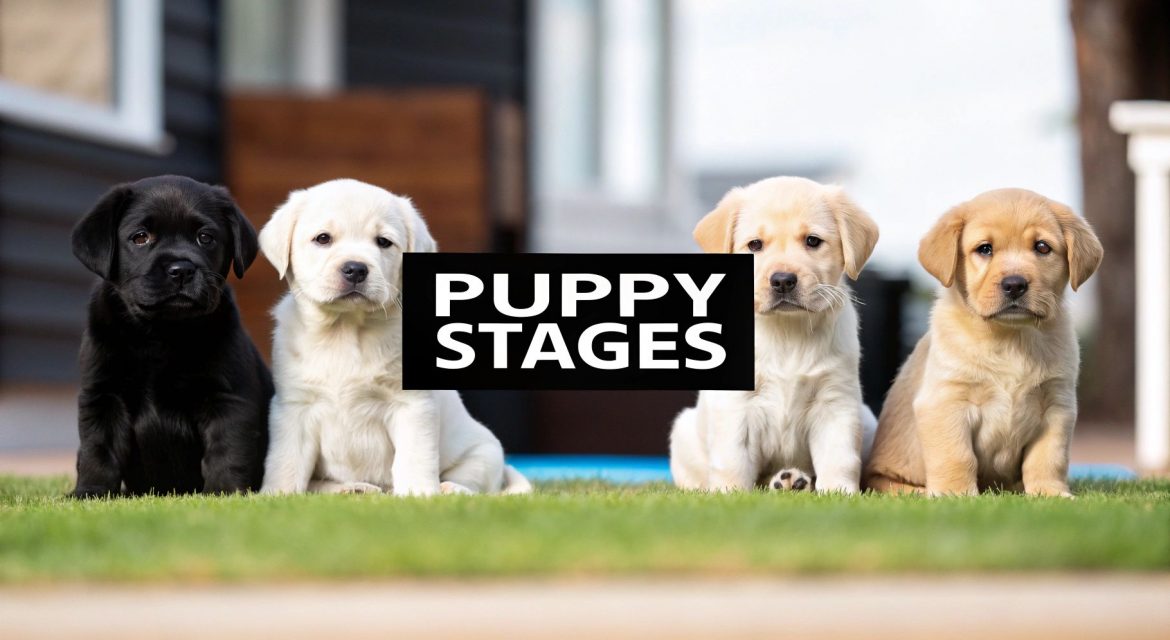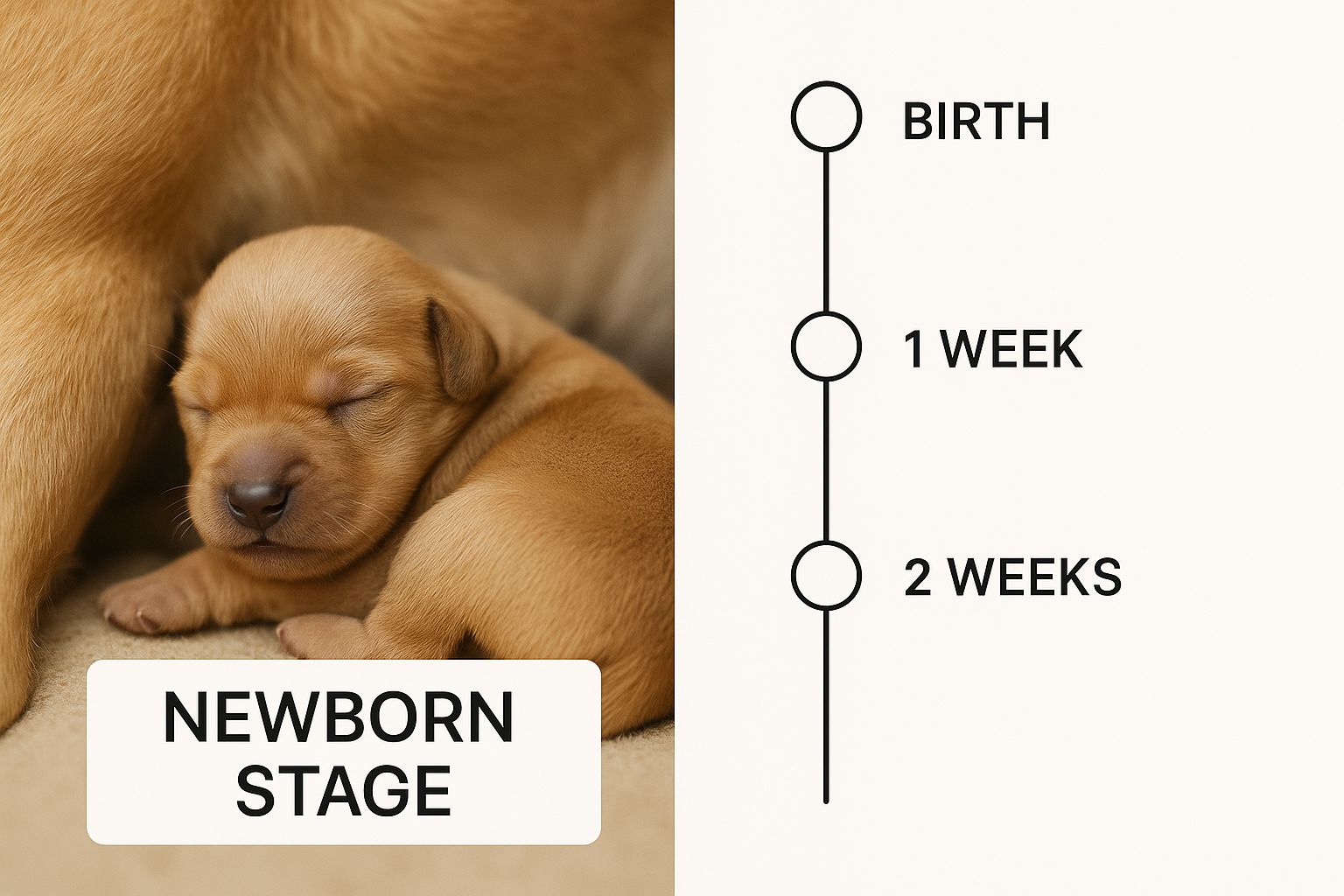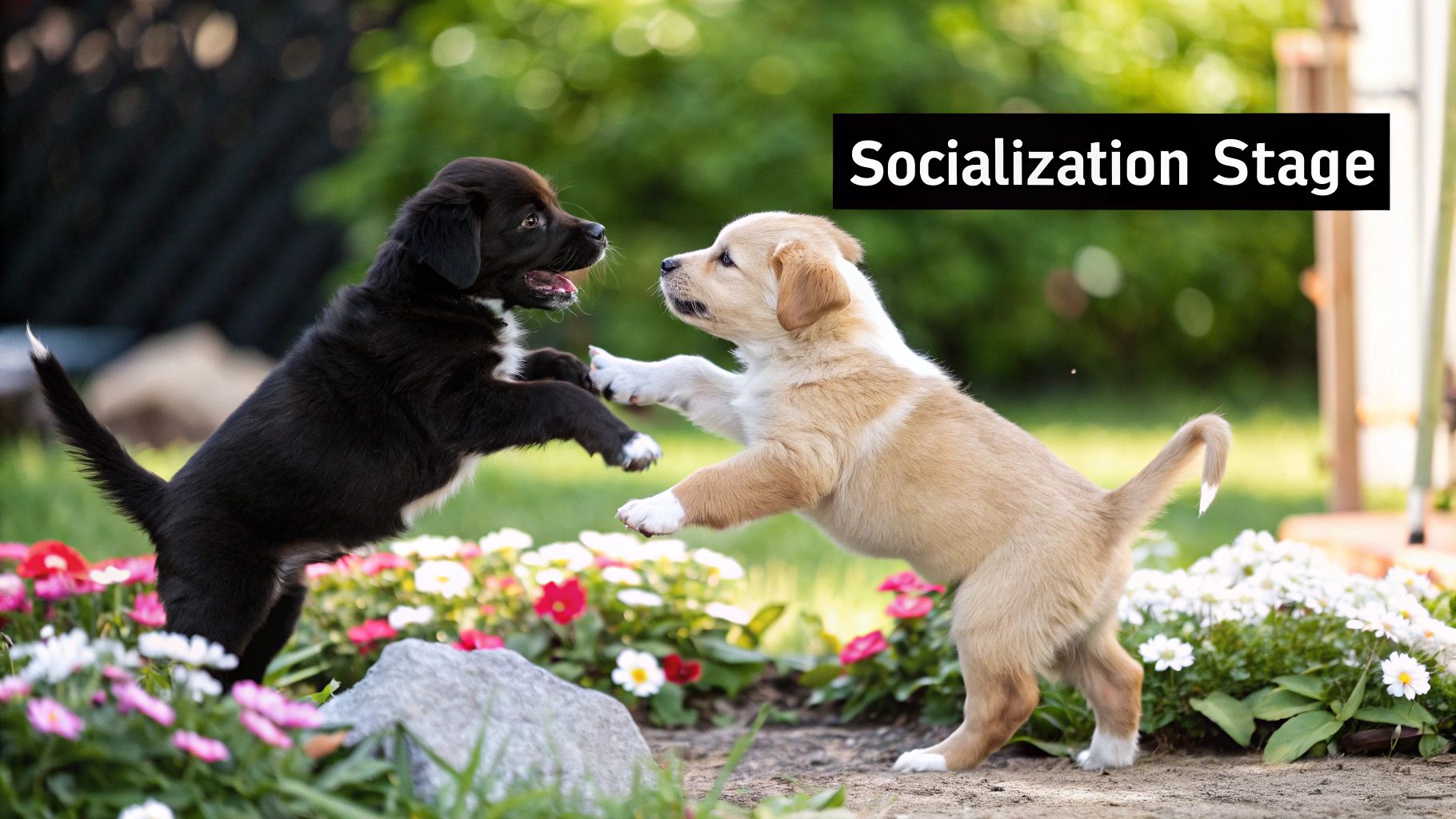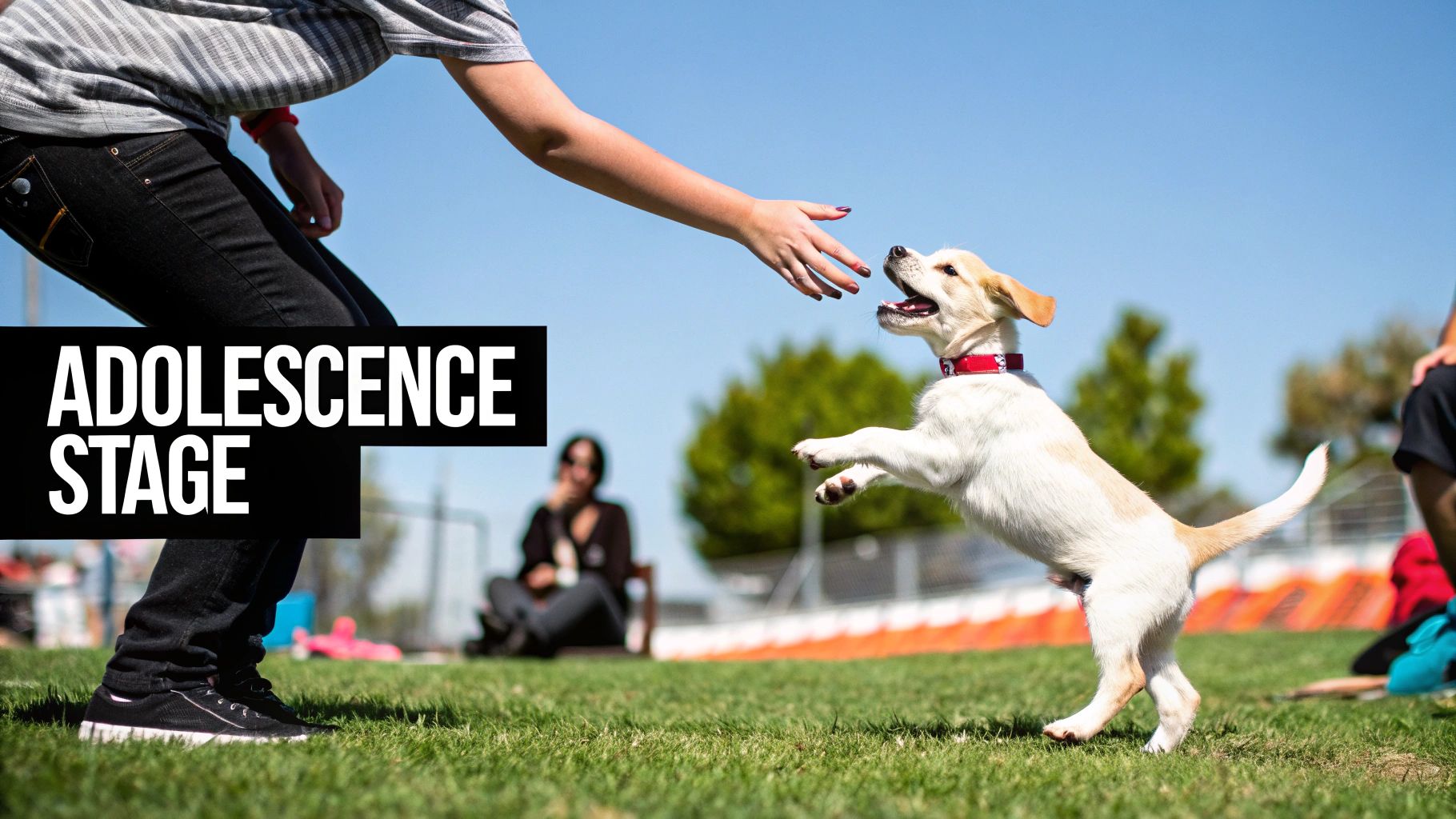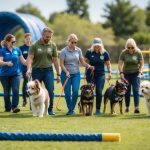Bringing a new puppy home is one of life’s purest joys, the start of an incredible adventure we get to share with them. Your puppy's first year is a whirlwind of growth, from the helpless newborn phase, through a critical socialisation window, and even a rebellious teenage stage, before they finally blossom into a young adult.
Knowing what to expect at each stage is the key to raising a happy, confident, and well-behaved companion.
Your Puppy's First Year: A Growth Timeline
So, you’ve decided to embark on one of the most rewarding journeys you'll ever take: raising a puppy. It's a flurry of fluffy cuddles, tiny paws, and changes that seem to happen overnight. Watching your new best friend grow is amazing, but let's be honest, it can also feel a little daunting.
Are they learning the right things? Is this behaviour normal? Don’t worry, we’re here to walk you through it all.
Think of this first year as a series of chapters in your puppy's life story. Each one comes with its own milestones, unique challenges, and plenty of happy moments. By understanding what’s going on inside their rapidly developing brain and body, you can give them the exact support they need, right when they need it. This builds a rock-solid foundation of trust and strengthens your bond for a lifetime.
It all starts with the quiet, sleepy newborn stage.
This image beautifully captures the very beginning of life, a time when a puppy is completely dependent on their mother for warmth, food, and comfort.
To give you a bird's-eye view of the journey ahead, here’s a quick summary of what you can expect.
Puppy Development At a Glance
| Stage | Typical Age Range | Key Developments | Your Main Role |
|---|---|---|---|
| Newborn | 0 – 2 Weeks | Complete dependence on mum; senses are developing. | Provide a warm, safe environment for mum and pups. |
| Transitional | 2 – 4 Weeks | Eyes and ears open; begins to stand and walk. | Gentle handling; ensuring a clean, secure space. |
| Socialisation | 3 – 12 Weeks | Learns social skills; fear period begins. | Positive introductions to sights, sounds, and people. |
| Juvenile | 3 – 6 Months | Teething and chewing; increasing independence. | Consistent training, patience, and lots of chew toys! |
| Adolescent | 6 – 18 Months | Testing boundaries; hormonal changes. | Maintain structure, continue training, and stay patient. |
Preparing for Each Stage
Knowing what’s around the corner helps you feel prepared and confident. From navigating the sharp-toothed teething phase and mastering house training to teaching them how to interact politely with the world, every step is a building block for the amazing adult dog they’re destined to become.
A puppy’s first year is a period of immense physical and mental growth. Your role is to be their patient teacher, trusted protector, and biggest cheerleader through every developmental leap they take.
Of course, all this growing needs the right fuel. Just as your puppy's training needs will change, so will their dietary requirements. To find out exactly what and when to feed them, you can check out our detailed guide on creating a puppy feeding schedule by age.
Now, let's dive into each stage and celebrate every milestone together.
The Newborn and Transitional Stages
Let's start right at the very beginning, in the first few weeks of a puppy's life. This is where their story begins, long before they even set a paw in your home. Understanding these foundational moments helps you really appreciate just how incredible their journey is.
From birth up to about four weeks, a puppy goes through some of the most dramatic changes of its entire life. This period is split into two distinct, almost magical phases: the newborn (or neonatal) stage and the transitional stage. It’s a time of complete dependence, followed by a rapid awakening to the world.
The Neonatal Stage: A World of Touch and Warmth (0 to 2 Weeks)
When a puppy first enters the world, they are incredibly vulnerable. Think of them as tiny, helpless beings whose entire existence revolves around two things: their mother and their littermates. For the first two weeks, they are completely deaf and blind, experiencing life only through touch and smell.
Their days are simple: eating, sleeping, and staying warm. In fact, they spend about 90% of their time asleep, which is absolutely vital for their rapid growth. Their little bodies can't regulate their own temperature yet, so they instinctively huddle together with their siblings and mum for warmth. You’ll often see them twitching and making little noises in their sleep—this is perfectly normal and is thought to be their muscles developing.
During this time, their mother is their entire universe. She provides all their nutrition, stimulates them to go to the toilet, and keeps them clean and safe. As you can imagine, a calm, secure, and warm environment is non-negotiable for their survival and healthy development.
This early stage is all about survival and building strength. Though they can't see or hear you, gentle handling by a responsible breeder can start to associate human touch with warmth and safety—a crucial first step in their life with people.
The early stages of a puppy’s development in the UK follow a pretty clear timeline, and each phase is critical for healthy growth. During the neonatal stage, from birth to two weeks, puppies are almost totally immobile and dependent. You can explore more about these initial puppy development milestones from Pooch & Mutt.
The Transitional Stage: A Sensory Awakening (2 to 4 Weeks)
Just when you think they’ll be tiny, helpless pups forever, the transitional stage kicks in. This period, from two to four weeks, is like watching a flower slowly open. It’s a time of incredible firsts as their senses start to come online, connecting them to the world in a completely new way.
The most exciting milestones happen now:
- Eyes Open: Sometime between 10 and 14 days, their eyes will begin to open. Their vision is blurry at first, more like seeing shadows and light, but it’s their first proper glimpse of their surroundings.
- Hearing Begins: Shortly after their eyes open, their ear canals will also unseal. They’ll start to be startled by noises and will begin to recognise the comforting sounds of their mother and the playful yips of their siblings.
- First Steps: They’ll start to push themselves up, moving from an army crawl to a wobbly, uncertain stand. Before you know it, they’ll be taking their first clumsy steps—it's a truly heart-warming sight.
With their senses awakening, their little personalities start to bubble to the surface. They’ll begin to properly interact with their littermates, moving beyond simply huddling for warmth. You’ll see the beginnings of play, with little growls, tiny barks, and clumsy pawing. This is how they start learning vital social cues and a concept called bite inhibition—discovering that biting too hard makes their siblings yelp and stop the game. It's their very first lesson in how to be a well-mannered dog.
Mastering the Socialisation Period
If there's one chapter in your puppy's life you absolutely must get right, it’s this one. The socialisation period, which runs from roughly 3 to 16 weeks of age, is hands down the most critical window for shaping your dog’s future personality.
Think of their brain as a tiny sponge during this time, eagerly soaking up everything about the world. What they learn now will stick with them for life. This is your golden opportunity to show them that the world is a safe, exciting, and friendly place. The experiences you provide will build a bedrock of confidence, helping them grow into a well-adjusted adult who can handle new situations without fear.
It's a short but incredibly powerful time, and we're here to help you make the most of it.
Why This Window Is So Important
During these crucial weeks, your puppy is figuring out what’s normal and what’s not. Positive exposure to different sights, sounds, people, and other animals helps them build a mental library of safe experiences. A puppy who meets a variety of friendly humans will learn that people are generally kind. A puppy who hears the vacuum cleaner and gets a treat will learn that loud noises aren't a threat.
Without these foundational experiences, they can develop fears and phobias that are much harder to tackle later on. This is why a well-socialised puppy is far less likely to become reactive or anxious as an adult. You are literally shaping their perception of reality.
The goal of socialisation isn't just to expose your puppy to as many things as possible. It's to create as many positive associations as possible, making sure each new encounter is a happy and safe one.
Your Socialisation Toolkit
So, how do you actually do it? The key is to be organised and intentional. It’s not just about a random trip to the park; it's about thoughtfully introducing your pup to all the little things that will be part of their life. Creating a checklist is a brilliant way to stay on track.
Here are some key areas to focus on:
- People: Introduce them to people of all different ages, appearances, and genders. Think hats, beards, glasses, wheelchairs, and children (always supervised!).
- Sounds: Let them hear everyday household noises like the television, washing machine, and doorbell in a calm setting. You can even play recordings of traffic or fireworks at a very low volume.
- Surfaces: Encourage them to walk on different textures, like grass, carpet, pavement, sand, and wooden floors.
- Environments: Safely expose them to different places, like a quiet corner of a pet-friendly shop, a friend’s house, or a short, calm car ride.
Remember, we want to keep these sessions short and sweet. The aim is to build confidence, not overwhelm them.
Reading Your Puppy's Body Language
One of the most important skills you'll develop is learning to read your puppy's cues. They can't tell you when they're feeling stressed, so it’s up to us to watch their body language. This lets you step in and support them before they become overwhelmed.
Look out for these subtle signs of stress or fear:
- Tucked Tail: A tail tucked tightly between their legs is a clear sign of anxiety.
- Lip Licking: Frequent licking of their lips or nose when no food is around.
- Yawning: A big yawn can be a sign of stress, not just tiredness.
- Cowering or Hiding: Trying to make themselves smaller or hide behind you.
- Whale Eye: Showing the whites of their eyes is a classic sign of discomfort.
If you spot any of these signals, it’s time to calmly remove your puppy from the situation. Forcing them to "face their fears" will only make things worse. Instead, increase the distance from the scary thing and pair it with something they love, like a high-value treat, to start building a positive association from afar. For a deeper dive, check out our guide on how to properly socialise a puppy.
Quality Over Quantity, Always
Finally, let's bust a common myth. Socialisation is not a numbers game. Taking your puppy to a chaotic dog park and letting them get swamped is the opposite of good socialisation. One positive, controlled interaction is worth more than ten stressful ones.
Your role is to be your puppy's advocate and protector. Make sure interactions with other dogs are with calm, friendly, and fully vaccinated adults who can teach them good manners. Always end every new experience on a positive note, even if it’s just one minute of calm observation followed by a tasty reward.
By getting this period right, you’re not just training a puppy; you’re raising a confident companion for life.
Just when you've caught your breath after the whirlwind socialisation period, a whole new adventure begins. Welcome to the juvenile stage, which usually kicks off somewhere between four to six months of age. Your once tiny, dependent puppy is suddenly bursting with a newfound sense of confidence and curiosity.
This phase is a bit like watching a child start to truly understand the world and their place in it. They know the basic rules you've taught them, but now they're keen to see exactly where the boundaries lie. You’ll notice them becoming more independent, more adventurous, and yes, sometimes a little bit cheekier. It's a completely normal part of growing up, and your job is to be their patient and consistent guide.
We get it—this stage can be a little trying. But it's also where you'll see their unique personality really start to shine through. Let's look at how to navigate this exciting time together.
The Rise of the Canine Teenager
Think of this period as your puppy's pre-teen years. They're leaving true puppyhood behind but aren't quite fully-fledged adults yet. This "in-between" stage brings a fresh set of behaviours as they start figuring out social dynamics and testing their limits.
You might see them:
- Ignoring commands they previously knew perfectly well.
- Pushing boundaries just to see what they can get away with.
- Chewing more intensely as their adult teeth settle in for good.
- Displaying more boisterous play with you and other dogs.
It’s easy to feel frustrated and think, "What happened to my well-behaved puppy?" But please know this isn't defiance for the sake of it. It’s a natural developmental step where they are learning about cause and effect. Your calm, consistent leadership is more important now than ever.
Consistency Is Your Superpower
If there’s one word to hold onto during the juvenile stage, it's consistency. Your puppy is like a little scientist, testing hypotheses every single day. If jumping up gets them attention one day but not the next, they learn that it's always worth a shot.
This is where clear, consistent rules make all the difference. Everyone in the household needs to be on the same page. If the rule is "no paws on the kitchen counter," it has to be the rule 100% of the time, not just when you happen to be watching.
Your puppy isn't trying to be naughty; they are trying to understand how their world works. By providing clear and predictable boundaries, you give them the security of knowing what is expected, which builds their confidence and reduces anxiety.
This consistency applies to everything—from feeding times and walk schedules to training cues. For a solid foundation, you might want to explore our expert advice on how to train a puppy effectively, which is full of practical tips that are perfect for this stage.
Managing Mouthing and Evolving Play
One behaviour that often ramps up now is mouthing. While they started learning bite inhibition with their littermates, they're now practising their skills on you. It's crucial that we teach them that human skin is delicate.
When they mouth you, immediately redirect their attention onto an appropriate chew toy. A sharp "ouch!" or withdrawing your attention for a moment can also send a clear message: playtime stops when teeth meet skin. Never resort to physical punishment, as this can create fear and badly damage your bond.
Their play style will also change, often becoming rougher and more physical. This is a great time to introduce more structured games like fetch or tug-of-war (with clear rules like "drop it"). Continued, supervised playdates with well-mannered adult dogs are also fantastic. These patient canine teachers can show your pup the ropes of polite play far better than we ever could, teaching your youngster when enough is enough and helping them develop into a socially savvy dog.
Surviving Your Puppy's Adolescent Phase
Just when you think you’ve got this puppy thing sussed, your sweet, obedient pup seems to vanish. In their place is a rebellious teenager who has apparently forgotten their own name. Welcome to puppy adolescence! It is, without a doubt, one of the most testing times you'll face, and we're here to help you get through it with your sanity—and your bond—firmly intact.
This phase usually kicks off around the six-month mark and can stick around until your dog is anywhere from 18 to 24 months old. It’s a messy cocktail of hormonal shifts, major brain rewiring, and a sudden, passionate interest in absolutely everything except you. If you’ve found yourself sighing, "But he used to be so good!" you're in exactly the right place.
Please, remember this: your puppy isn't doing any of this to wind you up. They are going through a natural, albeit maddening, biological process. Their brain is basically under construction. The connections that made their recall so reliable last month are temporarily offline while new, more adult pathways are being forged.
What Is Happening to My Puppy?
So, what’s really going on in that fluffy head? A huge surge of hormones is flooding their system, compelling them to explore, push boundaries, and seek a bit of independence. Think of it as the canine equivalent of a teenager slamming their bedroom door. Suddenly, the world outside is infinitely more fascinating than the person holding the lead.
This is also a time when a second fear period can crop up. You might notice your once-confident pup is now spooked by things that never bothered them before, like a garden gnome or a plastic bag rustling in the wind. It’s a confusing time for them, and they need your patient guidance more than ever.
The adolescent period, often starting at five months and lasting up to 30 months in some larger breeds, can be the toughest stage for owners. UK canine trainers stress the importance of patience and consistent training reinforcement to navigate the inevitable stubborn streak. You can find more professional advice on handling dog development stages on eastcoastdogtraining.co.uk.
Common Adolescent Challenges and How to Cope
Navigating this phase is all about good management, consistency, and a healthy sense of humour. Your previously perfect little angel might suddenly develop a few frustrating new habits.
Let's break down the most common culprits:
- Selective Hearing: Does their name suddenly seem optional? This is classic teenage behaviour. The allure of a squirrel or a captivating smell is just more powerful than your voice right now.
- Leash Pulling: Walks can quickly turn into a battle of wills as their burning desire to explore completely overtakes their loose-lead walking skills.
- Training Regression: Sit? Stay? What are those? It's incredibly common for them to seemingly forget every command you've ever taught them.
- Increased Energy and Restlessness: Get ready for random bursts of zoomies, often at the most inconvenient times.
The key is not to get disheartened. This is just a phase, not a permanent change of character.
Your job during adolescence is to be a patient, consistent, and predictable anchor in your puppy's chaotic world. Go back to basics, celebrate the small wins, and remember the well-behaved dog is still in there.
Practical Strategies for Teenage Turmoil
Instead of getting into a constant battle with your teenage tearaway, let's focus on proactive ways to manage their behaviour and keep your bond strong. Think of it as turning the difficulty setting down while their brain recalibrates.
Here’s how you can survive and even thrive:
-
Go Back to Basics: Shorten your training sessions and make them incredibly fun again. Use high-value rewards (we’re talking real chicken or cheese, not just dry biscuits) to make yourself far more interesting than the environment. Practise recall on a long line in a quiet park, not a busy field full of distractions.
-
Manage the Environment: Don't set your pup up to fail. If they’re pulling on the lead, try a front-clip harness to give you better control without a power struggle. If they’ve started chewing furniture again, limit their freedom in the house when you can't supervise them directly.
-
Enrich Their Minds: A tired dog is a good dog, but a mentally tired dog is even better. This is the perfect time to bring out puzzle toys, play scent work games, and use snuffle mats. Engaging their brain can be more exhausting than a long run and it channels all that restless energy constructively.
-
Prioritise Calm: With their brain on high alert, it's vital to teach them how to switch off and settle. Reward calm behaviour whenever you spot it, even if it’s just for a fleeting moment. Capturing calmness helps them learn that settling down is a rewarding choice to make.
Above all, be kind to yourself and your puppy. This stage is tough, but it really is temporary. By responding with empathy and consistency, you'll reinforce your bond and come out the other side with a wonderful, well-adjusted adult dog.
Your Puppy Development Questions Answered
We know this journey through the puppy stages can bring up a lot of questions. No matter how much you prepare, your little one will always find new ways to surprise you! We've been there, and we want you to feel confident and supported every step of the way.
That’s why we’ve pulled together some of the most common questions we hear from new puppy owners. Let's tackle these concerns together with clear, practical answers that will help you and your growing companion thrive.
When Is the Best Time to Start Training My Puppy?
This is a fantastic question, and the answer might be sooner than you think! You can begin gentle, positive training the very moment your puppy comes home, which is usually around eight weeks old. You're not aiming for perfect obedience, but for positive first experiences.
Start with the simple things, like rewarding them for responding to their name or for going to the toilet in the right spot. The key is to keep every session incredibly short—just a minute or two is perfect—and always fun. Think of it as a game! Once they've had their vaccinations, usually around 10-12 weeks, you can look into formal puppy classes, which are brilliant for socialisation.
The socialisation period (from 3-16 weeks) is a prime learning time. By introducing basic concepts early and positively, you're not just training; you're building a beautiful foundation for communication and trust that will last a lifetime.
Is My Puppy's Biting Normal Play or Aggression?
We hear this concern all the time, so please know you are not alone in worrying about those needle-sharp teeth! The good news is that mouthing and "play biting" are completely normal behaviours for a young puppy. It’s one of the primary ways they explore the world, much like a human baby uses their hands.
Play biting is how they learn a crucial skill called bite inhibition—figuring out how much pressure is too much. You'll usually see it accompanied by relaxed, happy body language, like a wagging tail or a bouncy "play bow." True aggression is extremely rare in young puppies and would involve much different body language, such as stiffness, growling, or showing their teeth in a threatening way. The best response is to consistently redirect their playful nips onto an appropriate toy, teaching them that human skin is off-limits for chewing.
Why Has My Adolescent Puppy Stopped Listening to Me?
Ah, the teenage phase! If you're nodding along to this question, please take a deep breath and know that this is a classic and temporary stage. Your puppy's brain is undergoing a massive rewiring, flooded with new hormones that make the outside world seem incredibly exciting and distracting.
It feels personal, but it truly isn't. The solution is to go back to basics with kindness and manage your expectations. Make your training sessions shorter again, much more engaging, and use higher-value treats to make yourself more interesting than that fascinating leaf blowing across the pavement. Practice in quiet, low-distraction environments first before trying to get their attention at a busy park. Above all, be patient and consistent. This phase will pass, and reinforcing your bond through positive, fun training is the best way to get through it together.
Beyond understanding their developmental stages, many puppy owners also have questions about maintaining a clean and comfortable living environment. You might find a helpful resource in this guide to keeping your home fresh with pets.
What Is Most Important During the Socialisation Period?
The single most important goal of the socialisation window (from 3 to 16 weeks) is to create positive associations with the world. It's all about quality over quantity. Rushing your puppy through a hundred new experiences can be overwhelming, but a handful of happy, calm encounters can build a lifetime of confidence.
Your focus should be on:
- Positive People Encounters: Safely introduce your puppy to a variety of people (different ages, appearances) and let the interaction be on their terms.
- Exploring Sights and Sounds: Let them experience everyday things like the hoover or a car ride in a calm, controlled way, pairing the experience with treats.
- Safe Dog Interactions: Ensure they only meet friendly, vaccinated adult dogs who can teach them good manners.
- Navigating New Surfaces: Encourage them to walk on grass, pavement, carpet, and other textures to build their confidence.
Always let your puppy approach new things at their own pace and never force an interaction. You are their trusted guide, showing them that the world is a safe and wonderful place to explore.
At My Life My Dog, we're committed to being your partner through every stage of this amazing journey. We provide the expert guidance and support you need to raise a happy, healthy, and well-behaved best friend. For more in-depth articles on training, nutrition, and health, explore everything we have to offer at https://mylifemydog.com.


